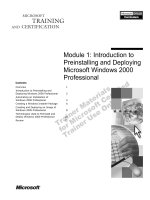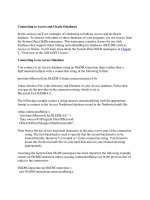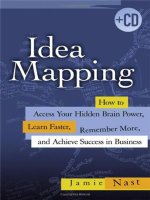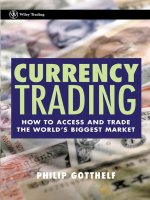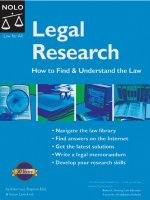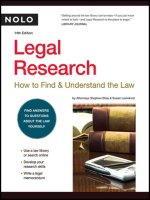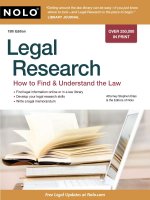Currency Trading: How to Access and trade the Worlds Biggest Market. doc
Bạn đang xem bản rút gọn của tài liệu. Xem và tải ngay bản đầy đủ của tài liệu tại đây (5.6 MB, 315 trang )
CURRENCY TRADING
How to Access and Trade the
World’s Biggest Market
Philip Gotthelf
John Wiley & Sons, Inc.
CURRENCY TRADING
How to Access and Trade the
World’s Biggest Market
Philip Gotthelf
John Wiley & Sons, Inc.
Copyright © 2003 by Philip Gotthelf. All rights reserved.
Published by John Wiley & Sons, Inc., Hoboken, New Jersey
Published simultaneously in Canada
No part of this publication may be reproduced, stored in a retrieval system, or
transmitted in any form or by any means, electronic, mechanical,
photocopying, recording, scanning, or otherwise, except
as permitted under Section 107 or 108 of the 1976 United States copyright
Act, without either the prior written permission of the Publisher, or
authorization through payment of the appropriate
per-copy fee to the Copyright Clearance Center, Inc., 222 Rosewood Drive,
Danvers, MA 01923, 978-750-8400, fax 978-750-4470, or on the web at
www.copyright.com. Requests to the Publisher for permission should be
addressed to the Permissions Department, John Wiley & Sons, Inc., 111 River
Street, Hoboken, NJ 07030, 201-748-6011, fax 201-748-6008, e-mail:
Limit of Liability/Disclaimer of Warranty: While the publisher and author
have used their best efforts in preparing this book, they make no
representations or warranties with respect to the accuracy or completeness of
the contents of this book and specifically disclaim any implied warranties of
merchantability or fitness for a particular purpose. No warranty may be
created or extended by sales representatives or written sales materials. The
advice and strategies contained herein may not be suitable for your situation.
You should consult with a professional where appropriate. Neither the
publisher nor author shall be liable for any loss of profit or any other
commercial damages, including but not limited to special, incidental,
consequential, or other damages.
For general information on our other products and services, or technical
support, please contact our Customer Care Department within the United
States at 800-762-2974, outside the United States at 317-572-3993 or fax 317-
572-4002.
Wiley also publishes its books in a variety of electronic formats. Some
content that appears in print may not be available in electronic books.
For more information about Wiley products, visit our web site at
www.wiley.com.
Library of Congress Cataloging-in-Publication Data
Gotthelf, Philip.
Currency trading: how to access and trade the world’s biggest market /
Philip Gotthelf.
p.cm (wiley trading)
Includes index.
ISBN 0-471-21554-6 (alk. paper)
1. Foreign exchange futures. 2. Foreign exchange market. I. title. II. Series.
HG3853.G68 2003
332.45 dc21 2002190743
Printed in the United States of America
10987654321
This book is dedicated to my wife, Paula and my
daughters, Jenna and Rikki. Their permission to write
instead of play is responsible for this book.
Founded in 1807, John Wiley & Sons is the oldest independent
publishing company in the United States. With offices in North
America, Europe, Australia and Asia, Wiley is globally
committed to developing and marketing print and electronic
products and services to our customers’ professional and
personal knowledge and understanding.
The Wiley Trading series features books by traders who have
survived the market’s ever changing temperament and have
prospered—some by reinventing systems, others by getting
back to basics. Whether a novice trader, professional or
somewhere in-between, these books will provide the advice
and strategies needed to prosper today and well into he future.
For a list of available titles, please visit our Web site at
www.WileyFinance.com.
ACKNOWLEDGMENTS
Special thanks are extended to those who helped compile facts,
figures, and assisted in linguistic constructs that readers should
be able to understand. I thank my wife, Paula for her patience and
editing skills. I am sure her comments improved the quality of
this book. Thanks to my associates Ron Goodis and Martin C.
Niemi for working out trading examples and helping to acquire
facts and graphic figures. I am forever grateful to Robert W. Hafer
who provided access to charts and data while he was with Bridge/
Commodity Research Bureau. I want to thank the many indi-
viduals at the International Monetary Market (IMM) of the
Chicago Mercantile Exchange and my friends at FINEX for
providing contract specifications and access to international
monetary statistics. Thanks are extended to various Refco FX
Associates and Bruce Pollack for providing screen shots and per-
mission to use them.
Special acknowledgement is extended to Edward M. Bern-
stein, Esq. whose diligent efforts provided me with the time to
complete another text. In turn, Ed and I thank Robert LoBue, Esq.
and Stuart Karl, Esq. for their persistence and perseverance that
aided in the growth of my nest egg and helped me pursue more
extensive trading endeavors.
Finally, I want to acknowledge a very special individual, Ariel
Jacobs, who lost his life during the September 11th 2001 terrorist
attack upon the World Trade Center. Ari worked for FutureSource
as Senior Vice President/National Sales Director. Ari provided the
original permission to include FutureSource data and statistics in
this book. He left this world on his birthday and just prior to the
birth of his first child. Those who knew him appreciated his
youthful energy and sincerity. He was an asset to his company
and his customers. He will be missed.
v
TABLE OF CONTENTS
Introduction 1
Chapter 1 Money, Currency, and Foreign Exchange (Forex) 9
Chapter 2 Understanding Parity 23
Chapter 3 The Wealth of Nations 39
Chapter 4 Shifting Sands of Fundamental Analysis 63
Chapter 5 Interventions, Scams, Rouges, and
Manipulations 99
Chapter 6 Understanding the Markets of Cash, Futures,
and Options 115
Chapter 7 Practical Trading Strategies 159
Chapter 8 Market Behavior 193
Chapter 9 Great Expectations 269
Appendix 283
Index 299
vii
INTRODUCTION
In 1972, my father, the late Edward B. Gotthelf, met with Everett
Harris, President of the Chicago Mercantile Exchange, to discuss
promoting their new International Monetary Market (IMM).
Major world currencies were being floated against the dollar under
a new Smithsonian Agreement consummated in December 1971.
The exchange was working swiftly to create foreign currency
futures that would take advantage of an expanded fluctuation
band from 1 to 4.5 percent. Although this was hardly the kind of
dramatic swing seen in some agricultural markets, this evolu-
tionary development represented the potential for a 9 percent trad-
ing range from top to bottom. Approximately 4 months later,
western Europe formulated their European Joint Float, which per-
mitted a 2.5 percent intermember parity fluctuation labeled the
snake and a 4.5 percent band against the dollar called the tunnel.
Again, the implied range against the greenback was 9 percent.
If memory serves me correctly, a gentleman named Mark
Powers was involved in making currency futures a reality. This
bold plan represented the birth of financial futures and a new era
of derivative trading. Founders of currency futures appropriately
reasoned that a 1 to 10 percent margin would magnify a 9 percent
trading range by several hundred percent. Consider that a 5 per-
cent move against the dollar translates into a nickel. If you only
need .01 to .001¢ to accomplish this trade, your potential profit
is 500 to 5,000 percent.
Fortunately, no insider trading restrictions applied to com-
modity markets. When I visited home from college, my father
excitedly explained the enormous profit potentials represented
by these new markets. He pointed out that certain currencies
such as the Japanese yen and Mexican peso were being revalued
against the dollar. However, IMM contracts hadn’t reflected the
anticipated changes.
1
It was my first official venture into commodity trading.
Using money earned through summer jobs and guitar perform-
ances in coffee houses, I funded my first currency trading ven-
ture. With less than $1,000, I took positions destined for
realignment. Within a few months, a few hundred dollars in mar-
gin ballooned into a whopping $7,000. Although this was not as
impressive as Hillary Clinton’s alleged gains in soybeans and cat-
tle, keep in mind that these were 1970’s dollars. I immediately
took my newly found riches and went car shopping. For those
familiar with cars of the 1970s, my choice narrowed down to the
Alfa Romeo Berliner at $2,800 and the BMW 2002 Tii at $3,200.
Imagine such prices! The remainder of my profits went toward
paying taxes, tuition, and (of course) party expenses.
Although the BMW represented the car at the time, I remem-
ber thinking, “$400! How can I afford the extra $400?” As of this
writing, $400 buys a modest New York dinner for four with a
decent wine, very few drinks, and perhaps dessert. I bought the
Alfa and admit that I drove that car for 17 years
—
until I married
my wife Paula, who refused to push-start the vehicle on cold
winter days. After all, we were married and she didn’t have to
play that game anymore!
Of course, the point of this introductory story is threefold.
First, it exemplifies the enormous amplification a 9 percent max-
imum trading range had when combined with a 1 percent initial
margin requirement. In effect, 9 percent became almost 900 per-
cent. By the 1990s, currencies bounced against each other in
multiple percentages. Daily volume grew to average an astound-
ing $1 trillion. World-renowned financier/investor George Soros
realized more than $1 billion over a few days when currencies
were adjusted in the fall of 1992. In addition, the story adds an
often forgotten perspective of changing currency value
—
the
effects of inflation. Most importantly, it demonstrates a funda-
mental transition in world currency structures from monetary
standards to commodities.Why is this important? Too fre-
quently, we overlook differences between monetary standards
and commodity valuation. For example, a dollar fixed to gold
eliminates gold’s speculative potential. Simply put, gold’s price
cannot fluctuate. The dollar effectively becomes gold and gold
becomes the dollar. Unlink gold and you have a commodity with
price fluctuation potential. Indeed, gold was disassociated with
2 Currency Trading
the dollar and President Nixon closed the U.S. Gold Window
early in the 1970s.
Modern Currency Speculation
When currencies were permitted to fluctuate more freely against
a dollar standard, modern currency speculation was born. Some
believe the new world of floating currencies is a prelude to dis-
aster. Without a physical standard such as gold, governments are
free to violate the public trust and play with the money supply.
Sooner or later, public confidence may be stretched to its limit
and the world might experience a confidence crisis. Such an
event would lead to a monetary meltdown that might make the
Great Depression seem like a minor interlude.
Parity
In a previous book I authored entitled The New Precious Metals
Market, I called attention to the relationships between physical
standards such as gold and silver and commodity standards that
rely upon relationships called parity. Interestingly, the parity
concept and term is conspicuously missing from modern cur-
rency trading vernacular and recently written texts. Being some-
what of a traditionalist, I return to the use of parity in this book
as a term of art and vital currency trading principle. Today’s cur-
rency traders can focus too closely upon the money. What is the
British pound doing today, this hour, minute, or even second? A
narrow focus misses the big picture. Currency buys commodities
and services. Currency has a value or standing relative to com-
modities and services. This is parity. It is expressed as a ratio or
a price.
Parity is where modern currency trading becomes exception-
ally exciting and broad. For the moment, we have global com-
modity markets trading in various currencies on an almost
continuous basis. Coffee quoted in pounds is also bid in dollars.
Oil traded in dollars may also require payment in euro currency.
Any time a commodity is valued in more than one currency,
there is an automatic cross-parity potential. This is commonly
Introduction 3
called arbitrage. Anytime a currency has multiple-parity rela-
tionships, there is arbitrage. However, the significance of cross-
parity is far greater than quick profit opportunities. The entire
structure of an emerging and changing global economic system
relies on maintaining parity.
Equally intriguing are technological and structural changes
in trading forums and mechanisms. Electronic tracking, order
execution, and accounting permit more precise and less danger-
ous arbitrage, as discussed in later chapters. Paths to riches are
diverse and expanding.
As readers will see, parity is obvious, but obscure. The prin-
ciple put forth by the mediaeval philosopher William of Occam
states, “non sunt multiplicanda entia praeter necessitatem,”
which means “things (such as, data, relationships, and observa-
tions) should not be multiplied (expanded) beyond their require-
ments or necessities.” This is known as Occam’s Razor or the
principle of parsimony. Parity is simplicity. We can pile up
trends, cycles, waves, neural net predictive equations, relative
strength, stochastic measurements, and a host of technical or
fundamental methodologies. In the end, we seek to define parity
and its possible change. Keeping it simple should be a universal
objective. Within the simple lies the secret to enormous wealth!
Efficient Market Theory
This raises another question often presented by skeptics who
insist markets are efficient and there are no realistic opportuni-
ties to achieve consistent trading success. Efficient Market
Theory states that markets almost instantly discount price-influ-
encing news. Thus, anything publicly known cannot generate a
profit. Again, referencing my earlier book on precious metals, I
predicted a rise in palladium beyond $1,000 per ounce and plat-
inum above $600, and a fall in silver below $4.50 and gold well
under $300. At the same time, I stated that the gold sector would
continue providing security and stock appreciation. These docu-
mented predictions were not divined or lucky guesses. They
were logically deduced from publicly known information well in
advance of the eventual price move. In fact, the behavior of the
group of four metals (gold, silver, platinum, and palladium) was
4 Currency Trading
generally predicted within the book using simple approaches
that have been market-proven before and since the publication
date.
The Goal of This Book
The purpose of this text is to provide an understanding of foreign
exchange trading. Although I may reference historic changes in
the international currency system, the past does not necessarily
reflect the future because the entire concept of foreign exchange
has changed and continues to change. The Bretton Woods Accord
is interesting, but irrelevant to today’s market. Debating a gold
standard is an interesting intellectual exercise, but may have no
bearing on how currencies are valued today.
Therefore, the ultimate objective is to get down to the busi-
ness of trading currencies to earn huge returns. I say huge
because it is an appropriate description. Just since the introduc-
tion of the euro currency, the U.S. Dollar Index moved 16 percent
while the euro currency futures plunged from 1.2200 to 0.8245
against the greenback
—
a whopping 32 percent. Using leveraged
futures or options, the profit potential magnifies more than 100
times. Perhaps calling this huge is an understatement. Before
that interim trend concluded, there was a 50 percent apprecia-
tion in the dollar relative to European currencies. After the ter-
rorist attacks on September 11th, the dollar finally reversed.
Amazing profit opportunities became available in 2002 by sell-
ing dollars or buying the euro, yen, Australian dollar, and even
the pound.
Of course, anyone can relate past movements. The key is
learning how you can participate. Along such lines, you must
know how you can trade in these exciting markets. There are
texts describing how professional currency traders and brokers
trade or how institutions use various markets and strategies to
deal with adverse currency fluctuations. However, one question
remains: How do you make money? If this is your question, read
on! Learn how various currency markets like futures, options,
Interbank, and forwards work. Discover why currencies change
value (parity) and see how market theory has been altered by
innovations such as interest rate futures, derivatives, and syn-
Introduction 5
thetic transactions. What do international trade balances do to
currencies? How do interest rates correlate with currency val-
ues?
You’ll want to know which markets are best for you. Should
you use the Interbank, futures, or options? What are the new
electronic markets and how can you take part? What are the
risks and exposures? After answering these basic questions, we’ll
explore predictive skills and methodologies. What are the time-
proven trading approaches? How can you potentially build
unimaginable wealth? Can you enjoy the excitement and fast
action?
There is also the concern about panics and monetary melt-
downs. How real are the possibilities and what can you do to pro-
tect yourself against such events? All too often, we assume good
times are here indefinitely. However, history demonstrates there
are economic and social cycles that can alter perception and crip-
ple public confidence. After all, the money you carry is no more
than paper with sophisticated printing. This paper may be
exchanged for tangible goods and services because you and your
counter party have faith in the paper’s value. But it’s just paper
—
more now than ever. What happens if we lose faith?
The Rapid Evolution of Modern Currency Markets
This is a truly exciting time for investors and evolving currency
markets. Over the next several decades, monetary systems and
methods of exchange and valuation will change. The consolida-
tion of individual western European currencies is only one exam-
ple. Electronic transactions represent an entirely new world of
opportunities. Globalization is an unknown phenomenon that
will surely reshape monetary systems and structures.
Before delving into how you can profit from trading curren-
cies, we must develop an appreciation for the speed with which
our world is changing. Technological advances are accelerating
at a nearly exponential rate. As an example, Gordon Moore
observed that the performance of transistor-based computer
chips was exhibiting a pattern of doubling capacity every 18 to
24 months. His observation was subsequently expressed as
Moore’s Law and has been supported by the data since his reve-
6 Currency Trading
lation in 1965. Indeed, computer chip advancement has been
exponential and there are powerful indications that the trend
will remain in place for many decades, if not centuries. With this
advancement in raw computing power, the human knowledge
base is exploding at an equally impressive rate. The possibility of
mapping the human genome was sheer fantasy just a few decades
ago. Now, the race to complete this formerly impossible project
is nearing completion.
Interestingly, as science moves us forward at a whirlwind
pace, the science of economics crawls forward at less than a
snail’s pace. Money has essentially remained the same for thou-
sands of years. It has only been since the 1970s that the funda-
mental concepts and construct of money have been changing.
Central banks are brand new in comparison with the history of
money. Gold and silver were briefly the basis for all global valu-
ation.
Yes, there have been new monetary ideas, products, and serv-
ices. We might liken the credit card to the first semiconductor or
transistor. How far have we come since then? However, there are
signs that more rapid monetary and money evolution is taking
place. Electronic cash may replace bills and coins. The euro cur-
rency is indicative of a monetary consolidation. The develop-
ment and growth in foreign exchange trading suggests a new
paradigm. As such, even the life span of this text may be brief as
the role of money, currency, and foreign exchange evolves and
changes.
Many of us recognize the enormous profit potential associ-
ated with evolving monetary systems and foreign exchange. Just
as Bill Gates seized on the phenomenon expressed as Moore’s
Law by augmenting hardware with software, individual investors
(like you and me) can grasp present and future wealth building
opportunities in the foreign exchange markets. Simply put, you
must be prepared if you want to profit. That’s what this is all
about.
Introduction 7
Chapter 1
MONEY, CURRENCY, AND
FOREIGN EXCHANGE (FOREX)
The most basic questions and concepts we must address involve
the differences between money, currency, and foreign exchange
(FOREX). All too often these terms are interchanged. With equal
frequency, the differences are blurred and misconceptions are
developed. Aren’t the three terms one and the same? The answer
is no.
The Barter Process and the Evolution of Money
Money is the primal evolution of barter. It was developed as a
convenient means for exchanging goods and services. If my edu-
cation correctly serves me, the first recorded book entries date
back 5,000 years ago to the Sumerians who were defined as the
first society. Book entries could only become a reality as numeric
systems were developed. This is how money allegedly originated.
Certainly, there were methods to exchange goods and serv-
ices before the Sumerians. The barter process appears in cave
wall drawings and remains widely used today. However, barter
lacks efficiency because it inevitably involves considerable nego-
tiation to consummate a transaction. Value must be determined
through a process of bidding and offering. Sound familiar? For
example, suppose an ancient tribesman trapped a few beavers
while a fellow tribesman caught several fish. Not needing all the
9
beavers or all the fish, the two may decide to exchange beaver for
fish. Depending on the perceived value of beaver pelts in the
mind of the fisherman versus the relative hunger of the trapper,
some ratio of beaver to fish would be agreed upon.
Understandably, perceived values will change. The first inkling
of seasonality can be deduced from the previous example by over-
laying the need for warmth during the winter onto the nonseasonal
requirement for food. Logically, pelts should fetch more fish as
temperatures cool. The trapper is likely to fatten up during winter,
but go hungry in the summer. This suggests that the trapper will
expand his product line to include meat as well as pelts. This over-
comes seasonal problems. Both the trapper and fisherman must
spend the better part of their day accumulating their bounties.
Perhaps neither has time to build or maintain shelter. However,
another tribesman discovers that his lack of skills as hunter or fish-
erman is offset by his ability to construct sturdy huts.
The hut builder introduces the concept of cyclical supply and
demand as well as an underlying seasonal influence. He must
build huts when the weather is mild and there is easy access to
the ground. His unique challenge derives from his product’s dura-
bility coupled with seasonal supply. He develops a prolonged
barter whereby he swaps a hut for a year’s supply of fish or meat.
Thus, the hut builder’s commitment to exchange today is carried
forward in payments. Heavens! Was this the first mortgage?
The model grows more complex when the hut builder dis-
covers that the value of his trade exceeds his requirements for
fish and meat. Since he cannot consume all he has bartered for,
he decides to use his excess to acquire a wagon from the wagon
maker to transport his building materials and increase his effi-
ciency. Perhaps he also exchanges fish and meat for tools. The
increased efficiency only brings the hut builder more fish and
meat. He decides to train other hut builders with the under-
standing that they will work for him and receive a portion of his
meat and fish. The first real-estate tycoon is made. In all likeli-
hood, he doesn’t even pay for the land!
We see an economic system emerging from barter. All the
while, however, transactions and relative values must be negoti-
ated. Eventually, the hut builder’s tradesmen may decide to go
off on their own. Suddenly, there is competition in the real-estate
market. With equal certainty, the tribe will have many fisher-
10 Currency Trading
men, hunters, wagon builders, toolmakers, and other tradesmen.
If competition becomes heated, arguments can develop, and,
alas, we see the makings of war.
This is not necessarily a historically correct portrayal. The
metaphor simply illustrates how a barter economy develops and
functions. Reviewing and understanding this fundamental eco-
nomic system is important when we seek to determine FOREX
trading strategies based upon relative values for global goods and
services. With the decline of colonization, nations have become
regional. Since global resources are highly regional, national
wealth becomes a function of location, population, and sophisti-
cation. In turn, national wealth determines a currency’s relative
strength or weakness.
Although this concept will be covered in later chapters, I
won’t hold you in total suspense. Some basic examples can be
illustrated by Middle East oil or South African gold and plat-
inum. These natural and valuable resources provide foundations
for national economic security. They also fuel currency
exchange. Japan relies upon ingenuity to efficiently convert raw
materials into finished goods. The yen’s value rises and falls rel-
ative to Japan’s innovation and related exports. Each nation relies
upon particular resources to derive wealth. As we will see, this
wealth is a driving force behind fluctuating currency values.
However, it is not the only driving force.
Returning to our barter example, we can identify a need for a
more efficient method of exchange. A toolmaker observes that
some metal materials have a mysterious attraction. A shiny yel-
low metal is far heavier than the harder bronze he uses for an ax
or hammer. His neighbor takes a fancy to the yellow metal and
offers to exchange his skills as an artisan for a portion of the
shiny yellow metal. Incredibly, the entire tribe, as well as other
tribes, finds this yellow metal universally attractive. Of course,
this metal is gold. After a sufficient quantity of gold becomes
available, tribal members decide to mold it into uniform pieces
called coins. They examine a fundamental product like fish and
see that one fish fetches two beaver pelts. If they set the value of
one fish equal to one gold coin, then one gold coin buys two
beaver pelts. Thus, the value of a gold coin is established as a
ratio to a common barter product with a relatively stable per-
ceived value.
Money, Currency, and Foreign Exchange (FOREX) 11
This example of converting gold into money does not take
seasonal or cyclical values into consideration. It is only a way to
explain the probable transition from barter to money. You are
probably saying, “Tell me something I don’t know.” I emphasize
that basic concepts translate into a more precise understanding
of how FOREX works.
In reality, gold is a convenient example rather than a histori-
cally accurate account of how money emerged. Gold and even sil-
ver were too scarce to be effective forms of money. This is why the
Phoenicians resorted to shells, while other cultures minted cop-
per, tin, and iron or used glass, beads, and stones. This does not
imply that gold and silver were not used for exchange. However,
gold and silver’s widespread use for day-to-day transactions was
not common until far more sophisticated economies evolved.
As we will see, gold and silver were symbols of wealth and
stores of value. These metals were used for more substantial
transactions often involving exchange between kings or noble-
men. These metals represented the first significant form of
FOREX. Equally important, gold and silver were used to measure
overall and relative wealth. You may say, “Wealth is wealth.”
This truism stands; however, there is a concept of relative wealth
that plays an important role in determining modern interna-
tional currency trends.
The Family Tree of Money, Currency, and FOREX
Most of us are familiar with trading cards. Whether trading base-
ball or Pokémon cards, children probably develop their first sense
of value and negotiating skills by swapping trading cards. Indeed,
some of us learned through this same primal exercise in FOREX.
We can analyze card swapping in three ways. We can assume
each card represents a form of currency whereby a specific card
is likened to the yen while another symbolizes the dollar. We
immediately comprehend that the card’s value is directly associ-
ated with its scarcity relative to demand. Children instinctively
know that the more rare the card, the more valuable it becomes
relative to other cards or simply for outright purchase.
By the same token, children grasp the concept of storing
value when they refuse to relinquish extremely valuable cards
12 Currency Trading
regardless of the offer. Of course, this is where children may
appear irrational. After all, every card should have a price, right?
Interestingly, adults and, more significantly, entire societies can
enter periods of irrational savings. The concept of storing value,
regardless of alternatives, can be seen as a confidence crisis. In
the child’s case, he or she lacks confidence that he or she will
secure a replacement card. Suddenly, this card is the only such
card in the child’s mind
—
a must have or must keep. When
socioeconomic panic sets in, history suggests we fall back on pri-
mal wealth symbolism like gold, property, or essential assets.
Today, we call this a flight to quality.
Experienced currency traders might legitimately disagree
with equating each unique card with a unique currency. It is not
necessarily the case that the scarcest currency fetches the high-
est price or attains the greatest perceived value. In fact, the most
abundant currency, like the dollar, is frequently viewed as the
most valuable. Therefore, another viewpoint is that each playing
card represents a unit of currency similar to the $1, $5, $10, and
$20 bills going up to the highest denomination. In this example,
the trading card becomes money rather than currency. What’s
the difference?
Simply put, money represents the means of exchange within
its country of origin. When we think of money, we immediately
resort to the bills and coins in our pockets or purses. We rarely
conjure up an image of equalizing values between our pocket
cash and the money of western Europe or the Pacific Rim. The
difference is subtle, but consider that money has a fixed value
within its place of origin. If baseball cards had a fixed value, they
would not be negotiated. You would simply trade a known X
number of cards for a known Y quantity of cards. In turn, the
ratio of cards to each other permits different mixes of cards to
buy goods and services. Observation tells us this is not the case.
Trading cards change value in accordance with the inventories of
those making the bids and offers.
Today, money, currency, and FOREX are like a family tree.
Currency is money once removed. They are similar, yet they
operate in different forums for different purposes. Another way
to view trading cards expounds upon the market concept of the
bid and offer. At any given moment, groups of children sporting
different card inventories gather in separate markets to set their
Money, Currency, and Foreign Exchange (FOREX) 13
relative card values. Depending upon the inventories available
within each market, the same cards will take on different values.
Given the sophistication and indulgence of our newest genera-
tions, kids might plan to be in different markets at the same time
by communicating bids and offers via cell phone or email.
Behold, children participating in arbitrage!
When card values are exchanged in broad markets, we see a
metaphoric example of FOREX. Taking this forward another
step, money is used to buy local goods and services. Assume a
bushel of soybeans is worth $6. We know that a $1 bill and $5
bill will purchase a bushel of beans. If we use a $10 bill, we
receive $4 in change. A drought may drive soybeans higher,
whereas good weather may lower prices. If the price is stable at
$6, what is the same bushel worth in pounds (£)? The answer lies
in the relative value of pounds to dollars. Consider that if the
pound loses value against the dollar, U.S. soybeans become more
expensive in the United Kingdom, but remain the same price in
dollars. This is another way to differentiate money from cur-
rency. Recognize that this example uses a single commodity
priced in two currencies. When soybeans are sold in the United
Kingdom, local influences may make the price in pounds higher
or lower. Thus, local supply and demand prevails to set local
prices.
It does not take a great deal of perception to know where the
example culminates. If we remove the soybeans and simply trade
pounds against dollars, we are dealing in FOREX. In the FOREX
market, the supply and demand for different currencies at any
given moment establishes an exchange value
—
hence the expres-
sion foreign exchange. When you trade FOREX, you attempt to
anticipate fluctuations in relative currency values. More often
than not, you are not concerned with the price of local goods and
services in local monies. There is an obvious link between local
currency strength and weakness that is associated with inflation
and deflation. If the dollar is inflating while the pound is not,
there is a very good chance the pound will appreciate against the
dollar. Unfortunately, FOREX relationships have become highly
anticipatory. This means that today’s inflation might be dis-
counted by tomorrow’s anticipated price correction. The subtle
aspects of forecasting will be explained in later chapters. For now,
keep this concept in the back of your mind as we move forward.
14 Currency Trading


